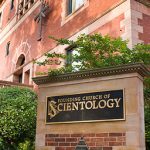The rise of New Religious Movements can be found alongside the history of the American West. The most obvious example of this is seen in the Church of Jesus Christ of Latter Day Saints, which was started in New York, but gained much of its religious clout during the trials and tribulations on the journey west and eventually achieved its famous stronghold in Salt Lake City, Utah. Following this ultimate success story, numerous New Religious Movements rise and fall over the course of the West’s history. An NRM is defined as a contested space on the outskirts of society’s religious landscape (Melton, 17) as it differs from the religions existing around it. All of these attributes apply to the Church of Scientology, founded in 1954 by L. Ron Hubbard and headquartered in Riverside County California. Beyond simple geographic location, as Scientology has churches and followers across the United States and the world, the Church of Scientology has tapped into the identity of the American West and used those values to gain a following amongst those looking for a faith centered around the individual practitioner.

While having a large canon written by Hubbard, Scientology officials do not encourage blind adherence to doctrine amongst their followers. Instead, they ask participants to ask themselves if the teachings of Scientology and their application directly benefit their quality of life (Bromley and Cowan, 170-171). Another key part of Scientology is the process of auditing, where participants talk to a counselor in order to resolve traumatic events (known as engrams) within a person’s soul (known as a thetan). One clear distinction between auditing and the sacrament of confession found within some Christian religions is that the auditor will only ask questions, and will not give judgment, advice, or penance to the participant, putting the official on an equal moral plane to the participant (DeChant and Jorgenson, 229-230). At its core, Scientology’s practices and beliefs place its focus on the believer as an individual as opposed to the Church as an institution.
Another defining feature of Scientology in America is its relationship with the United States government. Scientology was officially recognized as a religion in 1993 by the Internal Revenue Service and again by 9th Circuit Court of Appeals in 2012. However, regardless of this recognition (and the tax exemption that comes with it), the relationship between Scientology and the federal government is tenuous at best. This tension culminated in an event known as Operation Snow White, the largest incident of domestic espionage and infiltration in American history, as Scientology officials (including Hubbard’s wife) strove to steal and destroy unfavorable documents from government offices (Ortega, n.p.).
While taking a very unusual route, the role of the individual and the deep mistrust of the federal government found in Scientology are also deeply entrenched in the mythology of the West (White, 392). This identity serves as part of the reason why Scientology has been able to outlast the end of its founder, who died while in hiding in 1986.
–Catherine Mann, December 2016
Further Reading:
Behar, Richard (1991). Scientology: The Thriving Cult of Greed and Power, Time magazine.
Introvigne, Massimo (June 15, 2001). “The Future of Religion and the Future of New Religions”
The Oxford Handbook of New Religious Movements, (Oxford University Press, Oxford: 2008).
White, Richard. “It’s Your Misfortune and None of My Own”: A History of the American West (University of Oklahoma Press, Norman: 1991).
Featured Image: Victorgrigas, The Founding Church of Scientology. Used according to the terms of the Creative Commons License.